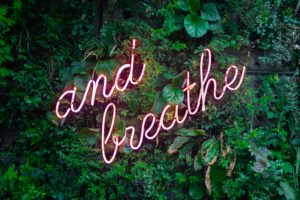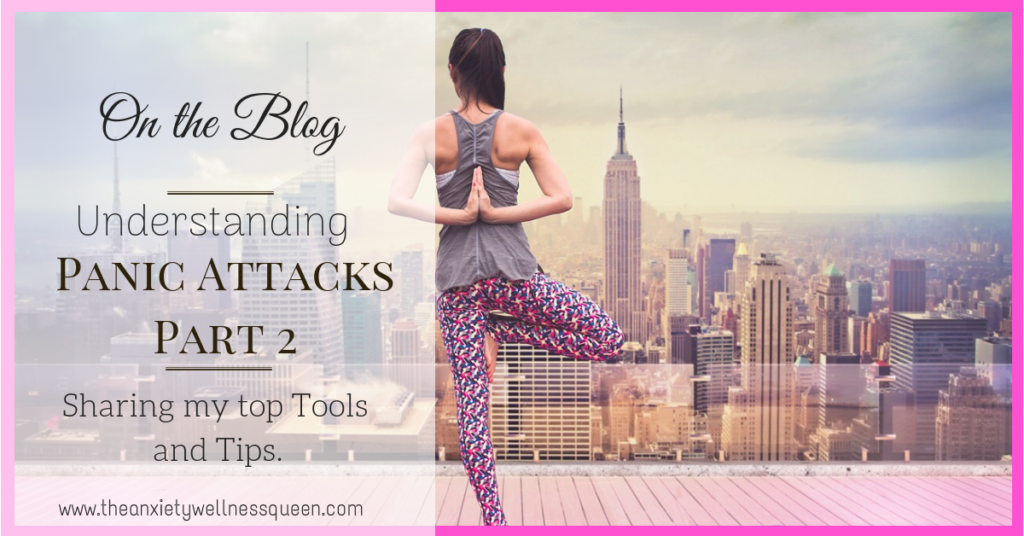In part 1 of the Understanding Panic attacks Series I introduced you to WHAT panic attacks are, the common SYMPTOMS to look out for and I chat a little about Agoraphobia (which is commonly linked to panic attacks). Today in Part 2 I am really excited about sharing some of my favourite tools and tips! There are so many and it was so hard to pick a few favourites but I know you will love them as much as I do and find them super helpful!
To be honest, when it comes to anxiety and panic attacks there are so many factors I consider when I make recommendations to my clients. My goal isn’t necessarily to just treat the symptoms themselves but to work on treating the cause, help them understand their bodies and why this is happening and together create a plan that works best for THEM (and their personal situation). In my experience this is really what enables the individual to achieve the best overall result!
Therapy (whatever type you might choose) is essential in working through the issues and to develop a new way of thinking and managing those anxious thoughts and feelings. Learning new coping tools, stress reduction practices and things you can introduce into your everyday life will make the world of difference! You will feel more confident in knowing that whatever life throws your way (and we all know that it will) that you have the knowledge and tools to help you through. Having that support along the way is comforting knowing that you don’t need to address life’s major challenges alone.
I’m going to be very frank here. In my experience no one thing alone will manage the anxiety for you (it will help but it won’t give you all the answers that you think you need). I think this is the reason where many have gone wrong in the past. You may have tried things like Mindfulness, meditation, nutrition, exercise, gratitude, managing anxious thoughts, new perspective, setting intentions, essential oils, and thought to yourself “well that didn’t work”. You might be right, because one of those things ALONE will not do it. It needs to be a holistic approach when dealing with anxiety and panic. You want to make sure you are including a COMBINATION of those things because Different PARTS of you and different AREAS of your life need to be addressed in different ways, (hence why one practice alone is not enough and won’t do the job). I work closely with my clients to work out what it is they will find the MOST helpful and why.
In saying all of that I am excited to share some of my top tips to help you manage your panic attacks and understand them that little bit better. It was so hard to narrow it down, but I think the ones I’m about to share with you will be the perfect place to start!
RECOGNISING YOU ARE HAVING A PANIC ATTACK
Awareness plays a crucial role in so many areas. One of those areas in your life is during a panic attack. Being aware of what is going on, recognising, identifying and verbalising to yourself that you ARE in fact having a panic attack and you are not dying or having a heart attack takes away a huge amount of the fear! Often that fear is of the unknown, of the future, the symptoms you are experiencing or fear of all the what ifs and should haves. It sounds so basic and simple right? Below are some examples of how you can do that.
“I am having a panic attack”
“These feelings are uncomfortable, but they will pass”
“I am safe right now”
“I am getting enough air”
“I am going to be ok”
BREATHE 
Often the first thing to go when someone starts experiencing a panic attack is the breathing. Many, will instead try to control their thoughts and start asking themselves things like “what is happening to me?” “am I dying?” “Why can’t breathe” “How can I stop this?” etc.. the thoughts are going in overdrive and the body is then responding to EACH and EVERY one of those thoughts and beliefs. During times of panic you will find yourself either hyperventilating OR holding your breath (mind you this is mostly happening without you even noticing). Naturally, both reactions will only create more panic and fear. Rather than giving in to the thoughts, practice focusing on taking lonnnngggg deep breaths.
It is really important right now to help calm down that fight or flight response and slowly getting the breath to a normal range. As a result the heart rate will slow down along with the other physical symptoms in the body. When you are focusing on the breath it also allows you to be more present and become less distracted by the anxious thoughts.
Here is a little Breathing exercise that you can start with..
Close your eyes (If it’s safe to do so) place one hand on your abdomen and one hand over your heart. Breathe in through your nose to the count of 4, Hold the breath to the count of 4, and breathe out to the count of 5 and continue. Take the breathing practice up a notch by incorporating some affirmations and even essential oils into your INHALE and EXHALE.
UNDERSTANDING YOUR THOUGHTS
This is one of the first things I start with when working with my clients. Teaching them how to understand, communicate with (yes you do communicate with your anxiety) and process their anxious thoughts. Having the knowledge and confidence to know what is going on and why plays a huge role in your overall anxiety and panic attacks. I find it is often the reason why fear is at the forefront of most peoples lives.
We generally refer to our thoughts as POSITIVE thoughts and NEGATIVE thoughts. It’s how we can understand what they are and how we can communicate them to others as well. Anxiety on the other hand is very specific when it communicates with you so there is already a discrepancy there. You both communicate with each other, although on very different levels. This only causes a whole bunch of confusion, misunderstandings and part of the reason that FOR THE LIFE OF YOU – you can not understand why the thoughts keep popping up and having the impact they do on you. This can be achieved by..
– Learning about all the different types of Automatic Negative Thoughts (ANTS). How to identify them and communicate with them.
– Knowing that you don’t have to accept every thought that pops up in your mind and that most of them are absolute liars!
– Knowing that you ARE allowed to answer them back!
– You are the boss! Just because the thoughts come from YOUR mind they are NOT you. You are not your thoughts or your anxiety.
LEARN ABOUT YOUR TRIGGERS
In Part 1 of the series I spoke about how for some people when it comes to their panic attacks they are aware of their direct triggers, although for others it feels like their panic attacks comes out of no where, with no direct triggers. A great way to become more familiar with this is by getting in the habit of taking note of the symptoms you begin having Pre- Panic Attack (many of you know when your about to have one).
– Ask yourself How do I know I am about to have one? Write it down.
– Take note of the times when your anxiety is at it’s highest (morning, night, around certain people, places, when you don’t eat, when you drink certain things etc..)
– Are you triggers Health related?
– Are your triggers based on the actions or well-being of others? (Partner, kids, family, friends
etc..)
– Are your triggers related to the things your eating or drinking? (Highly processed foods, Alcohol, caffeine, energy drinks etc..)
– Are your triggers based around specific thoughts?
– Do they occur in social settings, public places or in large groups?
– Sensory triggers (taste, sound, smell etc.) These triggers often react on a subconscious level. They might remind you of a past event, person or place that can set off your anxiety.
These examples are some of the things you could consider when trying to identify some of your triggers and contributing factors to your increased anxiety. As I mentioned in Part 1- I do NOT believe that Panic Attacks occur for no reason (even if that is how they feel at the time) they are usually a result of either a direct trigger or a build up of stressors and events over time.
GROUNDING

During a panic attack you feel like you are not in control. It feels like your thoughts are taking over, the physical symptoms are increasing and you have no control over your mind, body and what is happening to you.. there is no doubt whatsoever that it is scary!!
Grounding techniques come in so many different forms and it really is about exploring and seeing what works for you. I would consider this to be a form of Mindfulness because the overall goal is to gain focus, be present and of course GROUND YOU. You are using an anchor to ground you back into reality and how that feels for you Physically, Mentally and Emotionally. Note: Your mind and body is trying to protect you from the perceived danger during a panic attack hence why for some people it can feel like a ‘out of body’ experience or a ‘separation’ from reality.
I wanted to share a few grounding techniques with you today that are simple practices that you can do anywhere, anytime. It is helpful for you to be familiar with a selection of exercises so that you can choose something that works for you depending on where you are and what you need at the time.
– Sip on a cool drink (paying attention to the sensations, temperature and how it feels)
– Using mindfulness to redirect yourself and your attention to the here and now by incorporating your senses (What are 5 things you can see? 4 things you can feel? 3 things you can hear? 2 things you can smell and 1 thing you can taste?)
– You can do a grounding guided meditation (have some apps or podcasts handing on your phone and maybe keep some headphones in your bag)
– Take your shoes off and walk on (the grass, sand etc.) feel the texture and focus on what the sensations are.
– Use Balance essential oil (it is actually the grounding blend so what more could we want!) Apply a couple of drops in the palm of your hand with approx. a teaspoon of carrier oil (such as coconut oil or olive oil) rub your hands together and apply on the soles of your feet. Once you have done that cup your hands over you nose and mouth and take few deep breaths.
ESSENTIAL OILS
For me, Essential oils are always going to be included in the mix! They have the ability to work through the body to help calm down the central nervous, improve our mood and overall health. This can be achieved via the olfactory system by simply inhaling or diffusing as well as topical application on the body. Below I have included a few of my favourites to use during times of stress, overwhelm and panic!
Lavender Peace (also known as Serenity) – a Combination of very Calming oils. This is the first one that comes to my mind when I think of all things related to feelings of anxiousness, overwhelm, stress and panic. I often recommend to keep this in your handbag and pull it out whenever you need it! You can just apply a couple of drops in your palms ( same thing I mentioned with the balance above ) cup it over your nose and mouth and take a slow deep breath in, move your hands away from your face and slowly exhale and then repeat. Most people notice a response in their body quiet quickly its amazing!
Digest Zen – This is not one people typically think about when it comes to times of panic! (I believe it is a MUST for everyone) It is so handy to carry around at all times, I prefer buying the already pre mixed TOUCH bottles ( or u can make your own) it is always in my handbag for anything digestive/stomach related such as stomach upsets (great for kids as well), feelings of nausea, motion sickness, constipation, diarrhea etc.. which are all very typical symptoms when it comes to anxiousness, stress and panic. If you have the pre-diluted TOUCH Bottle just use the roller to apply on your stomach (around your belly button) and rub in a clockwise motion. The best bit is that you can apply this every 20-30 min until you feel like the symptoms have subsided.
Easy Air (also known as Breathe) – Easy air is for all things respiratory (so your probably wondering why I’m sharing it with you in this blog post). During times of panic, as you know, one of the first things you may feel is the shortness of breath. Easy Air applied to your chest (diluted of course or it is also available in a TOUCH version already pre diluted) opens up the air ways, which is exactly what you need during this time! Even though you and I know your breathing is not constricted in any way, it still FEELS like it is for you so this will just help you take those bigger, deeper breaths. It will send a signal to your brain saying YASSSS I CAN BREATHHEEEEEEE!!!! And your body then your body will adjust the symptoms accordingly. (such complex creatures we are right?? HA!)

Balance – I’ve spoken more about balance in the Grounding section but what I will add is that this one is also great to use during a meditation practice, I feel like it’s a good one for quieting the mind and to use for some intense emotions. Also a can be applied before bed when your finding it hard to switch your mind off.
Peace – An absolute favourite!! This is everything you need in a bottle. I personally like buying this pre diluted so that you can apply immediately when you feel those symptoms coming on. I would suggest doing it at the first sign of any symptoms, apply on the back of your neck, over your heart and collar bones (don’t forget to have a little smell straight out of the bottle before placing the lid back on). I’m not going to go into too much detail about this, I have a information saved about it in my ‘Highlights’ section on my Instagram so go and check it out under Essential Oils. This blend of oils really speaks for itself, when you try it you will understand exactly what I’m talking about!
If you want to learn more about these oils click HERE or if you would like to contact me with any questions in regards to getting your hands on some contact me HERE .
DON’T FIGHT IT
When something feels uncomfortable our first go to is to push it away. In this case you don’t want to be doing that, the more you push it away the stronger it becomes and the more frequently you will experience it.
“Whatever you fight, you strengthen, and what you resist, Persists.” – Eckhart Tolle
Allow it to come on, talk your way through it. Tell yourself what is going on (as its going on). For Example, I know I am having a panic attack, my heart is racing but I am not having a heart attack, I am feeling short of breath but I know I can breathe etc.. reminding yourself that your body is trying to protect you because it thinks your in danger. The problem with ongoing anxiety and panic is that the mind and body thinks you ARE in danger. There is this confusion between reacting because you are being chased by a bear!! Then reacting because your mind and body thinks you are being chased by a bear, eliciting the EXACT same response. “I know my body is trying to protect me but I am not in any danger. I am safe”.
When dealing with anxiety and panic Persistence is key! Persistence from you that is. We both know anxiety and panic is super persistent, it wont give up without a fight and its really up to you to apply the practices and keep going even when you feel like its not letting off. The most important thing I need to say here is that even though I am sharing tools and tips with you this does not need to be done alone. There are so many layers to anxiety, the way it presents itself, where it comes from, the limiting beliefs and the guilt and fear it comes with. It is very much like peeling the layers back on a onion. Each layer looks very similar yet is so different. Each layer is so important in understanding the overall story.
Please, Please don’t feel like you need to do this alone! There is so much help and support out there. For one would love to share more of my knowledge with you and support you along the way.
Please contact me if I can answer any further questions for you or if you are interested in working one on one with me.
I hope you found these tools and tips helpful and I look forward to sharing Part 3 of the series with you soon!
Much Love,





Amanda – I love how you’ve stated that the first step is acknowledging what is happening and that although uncomfortable it will pass. I’ve often gone to – “why is this happening!?!”
Thanks so much.
Hi Stacey, I’m glad you found it helpful. Thankyou so much for sharing your thoughts!
Amanda x